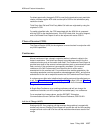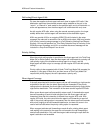
ASAI and Feature Interactions
12-26 Issue 7 May 1998
Single-Step Conference
A Single-Step Conference request is not allowed for a call in vector processing,
unless the visibility option in the request indicates “no visibility”. If a call is in vector
processing with the visibility option set to “full visibility”, the request will be denied.
Call Waiting
When an analog station is administered with this feature and a call comes in while
the user is busy on another call, the Alerting Event Report is sent to the
adjunct.This call is eligible for redirection via Redirect Call.
Centralized Attendant Service (CAS)
Starting with R5.5: Some customers may have CAS configurations in which
certain branch DEFINITY ECS systems have no direct connections to the public
network. In such configurations, ASAI adjuncts on these DEFINITY ECS systems
are not able to receive the cost of the outgoing calls to the public network because
the charging information is not passed back to the branch DEFINITY ECS
systems on Release Link Trunks (RLT). However, there is an instance in which a
centralized attendant at a main DEFINITY ECS system receives a call from a user
on a branch DEFINITY ECS requesting an outgoing Advice of Charge (AOC)
trunk on the branch ECS. The centralized attendant will seize a trunk on the
branch ECS and provide dial tone to the branch user. If the user connects with an
outside party and charging information is sent from the network, the charging
number in the Charging Event Report will be the branch station extension. The
interactions with CAS are identical to the attendant providing through-dialing on a
local ECS.
Class of Restriction (COR)
Direct Agent Calling is a field on the Class of Restriction (COR) form that must be
set to “y” for both the destination and originator. If either the originating or
destination party of the direct agent call
1
does not have the proper COR, then the
Third Party Make Call request is positively acknowledged, but the call is denied,
and the adjunct receives a Reorder/Denial Event Report. In the case of adjunct
routing, the COR of the associated VDN is used for calling party restriction
checks. If an adjunct attempts to route a call (via the Route Select capability) as a
direct-agent call, and if either the COR of the VDN associated with the route
request capability or that of the destination agent does not have the proper COR,
then the Route Select gets rejected with a Route End (cause CS3/43).
1. See discussion of originators in the ‘‘4. Direct-Agent Call’’ section in Chapter 4.


















